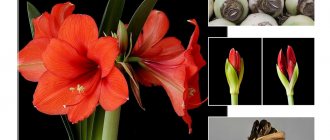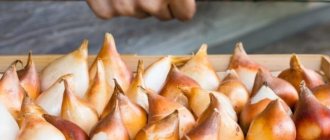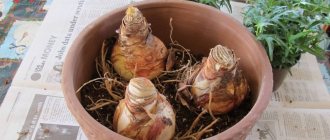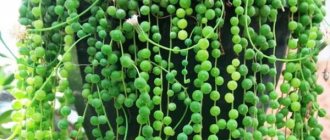How and when to replant hippeastrum?
Hippeastrums quickly take over the earthen ball in a pot and literally suck all the nutrients from the soil.
Expert opinion
Zakharov Igor Vyacheslavovich
Consultant at a furniture store. 5 years of experience.
Therefore, the plant can be replanted almost every year. When is it more convenient and painless for the plant to replant hippeastrum? The best period for transplanting a bulb is the time:
- before sending for storage during the rest period;
- after their “hibernation” comes out;
- before flowering;
- after flowering has completed, if we are talking about a recently acquired plant located in a transport pot and substrate.
Before replanting hippeastrum:
- Dead scales are carefully removed from the bulbs;
- study the root system, if necessary, cutting off rotten or damaged roots and treating the cut areas with a fungicide.
The soil for hippeastrum should be light, loose, low acidity and high in nutrients and mineral salts.
If you have to buy a ready-made mixture, for growing hippeastrum it is better to choose soil for bulbous crops, and then mix it with vermiculite or sand to make it loose.
When the earth mixture is made independently, use three parts of leaf soil and an additive of one part of humus; if necessary, sand and dolomite flour are mixed into the soil:
- To grow hippeastrum, a pot is enough, the walls of which are 3 cm away from the bulb. Larger containers are only detrimental to flowering.
- A drainage layer must be installed at the bottom.
- And the bulb is planted so that most of it remains above the ground.
In the summer months, the bulbs can be planted in open ground, where the same care for the hippeastrum, in the photo, continues as at home. And before frost, the bulbs are dug up and moved indoors.
Care at various stages of flowering and growth
At home, it is very important to organize hippeastrum into 3 main periods: dormancy (also called the first stage of forcing), forcing, flowering. When preparing the plant for the dormant period, you need to change its maintenance conditions: first stop feeding, then watering, then move it to a room with a lower temperature, preferably reducing it to 13 degrees. Some gardeners advise cutting off the leaves, others say that when they naturally wilt, they give up their strength to the bulb. When the leaves have withered and dried out, they can be removed simply by hand. After this, the bulbs are dug up, shaken off the ground and stored in a cool, dry place for 1 to 3 months. Some people put all the bulbs in a dry cardboard box, take them out to the garage or shed, others wrap them in paper and put them in the refrigerator. You can leave them in the ground, but before the second stage of forcing you will have to replant the plant.
To begin the second stage of forcing, the amaryllis is transferred to a warm, unlit place, watered abundantly, making sure that water does not get on the bulb. It is kept there, watered through a tray, until the peduncle reaches approximately 10 cm in height. Only then is the plant transferred to the illuminated windowsill of a warm room, where it is watered moderately and awaits flowering. It will occur at home within a month or a month and a half after the start of forcing.
Caring for a blooming hippeastrum means: water it moderately, feed it with fertilizers for flowering indoor plants every 10-14 days, turn it in the window so that the heavy peduncle does not lean to one side.
At the end of flowering, the wilted flower is cut off, and the peduncle will naturally die off, then it can be carefully pulled out without damaging the bulb. The leaves continue to grow, feeding is used to grow the bulb, and therefore to lay new leaves and inflorescences. At this time, it would be good to plant the plant in open ground, or at least take it out into the fresh air until the dormant period. Then the whole cycle repeats again.
At home, you can not introduce the plant into a dormant period, just leave it to grow in a pot, reduce watering, but then you cannot predict not only the time, but also the fact of flowering. New leaves will grow only after the old ones die, inflorescences laid in the last growing season will rise only after the leaves have been replaced. Therefore, if you want to admire the royal flowering of hippeastrum, you should provide it with a cycle: dormancy - forcing - flowering - dormancy. Moreover, knowing the approximate dates, you can achieve flowering at the right time, for example, in winter or by some personal date.
Air temperature and watering features when growing hippeastrum
To ensure that the plant has flowers for as long as possible, caring for hippeastrum at home involves creating optimal temperature and humidity conditions.
- Daytime air temperature is 20–22 °C;
- At night, the air should be slightly cooler, about 18 °C.
Hippeastrums do not like temperature changes; during storage it is important not to let the temperature drop below +5 °C, which can damage the flower buds. But in the garden, the plant can withstand short-term frosts down to –1 °C if it is covered with non-woven material.
The optimal air humidity for this type of bulbous plant is 75–80%.
Watering when growing hippeastrum also has its own specifics. Until the needle rises 10–15 cm, the plant is moistened moderately, making sure that the top layer of soil dries out between waterings.
As the flowers begin to open, the amount of moisture is increased, trying to prevent overwatering that is dangerous for the roots.
Feeding hippeastrum
The first feeding of the hippeastrum is carried out no earlier than 4–6 weeks after the plant “awakens”. Then the flower should receive support in the form of fertilizers every two weeks, and the last feeding is carried out for a month before sending the bulb to rest.
Fertilizing is always combined with watering so that the fertilizer gets into the moist soil.
Potassium is considered the most important element in the nutrition of the hippeastrum. When hippeastrum blooms, it is fertilized with a phosphorus-potassium mixture with a small addition of nitrogen.
As leaves appear, the proportion of nitrogen is increased, bringing it to the amount of phosphorus. From May until the end of summer, you can alternate feeding with organic and mineral fertilizers.
Expert opinion
Zakharov Igor Vyacheslavovich
Consultant at a furniture store. 5 years of experience.
If you use a complex ready-made composition, it is better to choose a mixture for bulbous plants, where the ratio of nitrogen, phosphorus and potassium is 1: 3: 4.5.
How to care for hippeastrum if the plant is grown without soil, in a solution of nutrients? In this case, for 10 liters of water you will need:
- 3 grams of magnesium sulfate;
- 9 grams of potash fertilizers;
- 3 grams of ammonium nitrate;
- 7 grams of superphosphate,
- as well as a mixture of microelements.
When growing hippeastrum, you need to remember that an excess of nitrogen can lead to diseases. Such bulbs can rot and tolerate the dormant period less well.
- Description
- When to replant?
- Transfer
- Care instructions
Hippeastrum is a beautiful bright flower that does not require special care. However, there is an important point in the maintenance of this culture: timely and competent transplantation. The splendor and brightness of flowering depends on this procedure.
Description
The plant belongs to the bulbous perennials. The bulb has a round or cone-shaped shape, a dense stem and closed scales.
The size of one bulb in diameter is 5–10 cm. The crop has linear foliage, the structure of the leaf plate on the outside is grooved, its lower part is keeled.
The leaves reach a length of 70 cm, their width is up to 5 cm. The color is green, although in some varieties the color of the leaves may have a reddish tint.
The inflorescence consists of 2–6 bisexual flowers up to 15 cm in length and up to 25 cm in diameter. Peduncle – 35–80 cm.
The flowers bloom in the form of a funnel or tube and have long petioles. The buds can be scarlet, burgundy, orange, pink, white and other colors.
The fruit is a capsule in which seeds ripen, characterized by excellent germination.
Before you start growing hippeastrum at home, you should familiarize yourself with the features of this crop in advance:
- light and white varieties produce a small number of quality seeds;
- in summer it will be more comfortable for the plant to be in the garden plot;
- The flowering period of the crop can be adjusted independently;
- flowering duration – 10 days;
- Only large bulbs are used for forcing;
- The most important stage in maintenance is proper transplantation.
Description of hippeastrum
Appearance
Hippeastrum (lat. Hippeastrum) is a perennial bulbous plant. The leaves are linear, shiny leaves, 50–70 cm long, 4–5 cm wide, and have shallow grooves on the surface. The leaves are arranged in two rows. During the flowering period, the plant produces a powerful, tall (up to 60–80 cm) peduncle.
The name of the flower is translated from ancient Greek as “star horseman”.
Hippeastrum during flowering is a source of pride and admiration
The flowers are funnel-shaped. Their color range is quite wide: red, white, orange, pink, purple, sometimes yellow or greenish shades. The main tone can be supplemented with strokes or specks.
The flowers are large - up to 20 cm in diameter, collected in an umbrella inflorescence. Hippeastrum has a very faint odor. Some species have no smell at all. This is a great advantage for people prone to allergic reactions.
Hippeastrum flowering - video
Natural habitat and home maintenance
The homeland of hippeastrum is the American tropics and subtropics, in particular the Amazon basin. It was brought to Europe in the 16th century and quickly gained admirers around the world. In 1799, the first hybrid Hippeastrum Johnson was bred. Today these flowers are widely used as a houseplant and are also grown for cutting. Hippeastrums are not particularly difficult to care for. Even novice gardeners can easily cope with this task.
Variety of hippeastrum varieties
This plant belongs to the Amaryllis family and has about 90 species and more than 2 thousand varieties.
In indoor floriculture, the hybrid hippeastrum (hippeastrum hybrida) is most often cultivated. The classification of varietal hippeastrums is based on two characteristics: flower size and shape. Depending on this, plants are conventionally divided into 9 groups, which are indicated in the table.
The most popular groups and varieties of hippeastrum - table
| Group name | Popular varieties |
| Large-flowered simple | Apple Blossom, Charisma, Showmaster, Minerva, Hermes |
| Medium flowered simple | Lemon Star, Magic Green |
| Small-flowered simple | Santa Cruz, Giraffe, Baby Star, Bianca, Neon |
| Terry large-flowered | Blossom Peacock, White Peacock, Sweet Nymphs, Dance Queen, Aphrodite, Lady Jane |
| Terry medium-flowered | Alfresco, Uniquay, Double Record, Elvas, Pasadena, |
| Terry small-flowered | Zombie |
| Sibistr | La Paz, Emerald, Chico, Rio Negro, Tiramisu, Melfi |
| Orchids | Papilio, Exotic Star, Ruby Star |
| Tubular | Pink Floyd, Amputo, Santiago, Germa, Rebecca |
Magnificent hippeastrums in the photo
Simple large-flowered hippeastrum with rim
Simple large-flowered hippeastrum striped
Simple medium-flowered hippeastrum
Simple medium-flowered hippeastrum with figured edge
Simple small-flowered hippeastrum
Simple small-flowered hippeastrum
"Star" splendor
Charming bouquet
Double large-flowered hippeastrum
Double-flowered hippeastrum
Double large-flowered hippeastrum
Sibistr
Orchid hippeastrum
Orchid Hippeastrum
Similarities and differences with amaryllis
Amaryllis is often classified as a hippeastrum variety, but this is erroneous.
Hippeastrum is often confused with amaryllis or the names of these flowers are considered synonymous. Even hippeastrum can be sold under the name “amaryllis” or vice versa. They are indeed relatives, belonging to the same botanical family - amaryllidaceae, but representing different genera.
Externally, these plants are very similar and require almost the same care. Biologically, they are structured differently. The main differences are presented in the table.
Biological differences between hippeastrum and amaryllis - table
| Characteristics | Hippeastrum | Amaryllis |
| Rest period | September–February. | June–September. |
| Flowering period | February March. | Autumn (at home - closer to winter). |
| Reproduction | Children are formed quite rarely. | Babies are regularly formed in the bulb. |
| Peduncle structure | Hollow. | Full-bodied. |
| Number of flowers in inflorescence | 2–6. | 8–12. |
| The smell of flowers | Practically absent. | Fragrant. |
| Features of the appearance of the peduncle | After the appearance of the fourth leaf or simultaneously with them. | First the peduncle appears, and towards the end of flowering the leaves appear. |
| Possibility of changing the life cycle | It is possible to artificially retire at any time, as well as stimulate flowering on a given date and re-blooming. | Life cycles cannot be “programmed”. |
When to replant?
If a crop does not bloom for a long time, then some maintenance conditions are probably not met: for example, a deficiency of useful elements in the old soil leads to a painful state. A hippeastrum transplant will help resolve the problem.
It is necessary to study the stages of the plant's life in order to know exactly when it is best to carry out the procedure. The most favorable times for replanting are:
- before the rest period of the bulb;
- during the first signs of development after a period of rest;
- until the arrow with buds is thrown out;
- after flowering and cutting the arrow.
In addition, the plant needs to be replanted after purchase, since a purchased pot and old soil will not bring productive results.
Adult specimens need to be replanted once every couple of years. For a young crop, the procedure is carried out every year. For any plant, young or adult, it is necessary to update the top layer of soil once a year. The best time of year for transplantation is spring.
Where can I get planting material?
For collectors of home hippeastrums, the planting bulbs “wander” from season to season. After flowering, they are sent to rest directly in pots, if the collection is small or the plants were initially planted in groups. A large flower garden is inconvenient to store in pots; the bulbs are dug up, dried, sorted, packaged and sent to rest in the pantry or refrigerator.
For the beginner, garden stores and flower centers offer a large selection of hybrid varieties. Most often the Dutch selection is on sale.
Recommendations for purchasing bulbs:
- buy according to the season - autumn or spring;
- choose only large, strong, hard onions (optimal size – 7-11 cm);
- inspect the condition of the neck and bottom (for red spots, seals, rot, blackening);
- the scales should be dry and brown in color;
- the presence of living roots is required (the shoots are visible through the drainage holes in the pot).
Advice . Beware of discounts and sales. Such promotions are organized either at the end of the planting season or to get rid of low-quality (contaminated) goods.
Transfer
To repot a plant, first select a container. Choose a pot that is several centimeters larger in diameter than the previous one.
Do not take containers that are too spacious, as in this case the plant will spend energy on producing babies rather than flowering. of maximum 2 cm between the walls of the container and the bulb The culture has a powerful and well-growing root system, and therefore it is better to choose a low but wide container.
The ideal option is a ceramic pot. This material ensures the roots breathe.
In addition, some specimens reach a large weight, and a container made of lightweight materials may not support the mass of the flower. For group planting, a long container is suitable; in this case, the gap between the bulbs should be 10 cm.
You also need to prepare the ground. The most favorable soil structure for culture is loose. To achieve a high-quality soil composition, combine in equal parts:
- turf land;
- leaf soil;
- humus;
- sand.
Prepare the onion.
- Take out the planting material, clean the head from dry scales to clean white tissue. The cleansing procedure will rid the bulb of bacteria and activate full development.
- Remove damaged and dry roots.
- Place the peeled onions in a solution of potassium permanganate for half an hour, and then dry well.
- If there are small children, they are eliminated so that they do not take away the strength of the parent bulb. If the grower plans to propagate the crop, then the children should be saved and then transplanted into a separate container, where they will begin to bloom in the third year.
When everything is ready, you can proceed directly to the transplant. It is done step by step.
- Create drainage at the bottom of the pot, for example, from expanded clay or crushed bricks. You can also put one stick of complex fertilizer there.
- Fill the container with soil.
- Plant the bulb in the ground. This should be done in such a way that the onion protrudes 1/3 above the surface.
- Compact the soil around the plant and moisten the soil.
- Place the pot in a well-lit, warm place.
For information on how to replant hippeastrum, see below.
Care instructions
Transplantation is the most important stage in the life of a plant. However, for the flower to fully develop, you need to follow a few more simple rules.
- The plant needs frequent fertilization . Feeding is applied before and during flowering, as well as for the development of children. The most preferred option is mullein solution. In summer, you can feed the crop once a decade. During the dormant period, which usually lasts from October to January, the plant does not need to be fertilized. You can also use mineral fertilizers as a top dressing at different times. For example, at the beginning of the growing season - nitrogen fertilizer (1 tsp per bucket of water), in the middle - phosphorus fertilizer (2-3 liters per bucket of water). Another important rule: prepare weak solutions as fertilizer.
It is better to water the flower several times with a slightly diluted product than once with a concentrated one.
Hippeastrum is a member of the Amaryllidaceae family. This genus includes approximately 90 species.
Expert opinion
Zakharov Igor Vyacheslavovich
Consultant at a furniture store. 5 years of experience.
The name of such a plant includes 2 Greek roots, which are translated as “horseman” and “star”. Very often, inexperienced gardeners mistake this plant for amaryllis.
However, it must be remembered that hippeastrum is naturally found in subtropical and tropical regions of America (including the Amazon basin), and amaryllis beautiful (representing a monotypic genus) can be found in southern Africa. These two plants are related to each other; they are considered representatives of the same family, but are classified into different genera.
This flower came to Europe in the 16th century, and its first hybrid appeared already in 1799, and it was named Johnson's hippeastrum.
Hippeastrum care
It is important to know how to properly care for hippeastrum at home in order to grow a beautiful and healthy plant.
The techniques and methods of caring for the plant do not have any features that distinguish them from other flowers, with the exception of a few.
Lighting
The light for a flower needs to be bright, but diffused. Direct exposure to sunlight can cause burns to tender leaves.
For uniform development of all parts of the crop, the flower pot is regularly turned to the light in different directions. When growing a flower in an apartment, a suitable place to place it would be a window sill in the southern part of the room.
Temperature
The air temperature in the room, which is comfortable for the flower, should be in the range from seventeen to twenty-five degrees Celsius. This temperature regime must be maintained throughout the growing season.
During the rest period, the temperature should be reduced. One of the features of caring for this flower is the desirability of placing it outside in the summer.
The most preferred method for this would be to bury it in the ground directly with the pot. At the same time, it is important to protect it from strong winds and drafts, and also to provide it with good drainage to prevent stagnation of water near the root.
Air humidity
The mode of maintaining air humidity is observed naturally for normal room conditions. Humidification is required only during the period when the heating devices are turned on to greatly dry out the air in the room.
Watering
However, the plant's watering regime is not simple. It is very important to ensure proper flower development.
The beginning of the growing season for a crop begins when a peduncle grows from the bulb. Until this point, watering should be moderate and done only after the top layer of soil in the pot has dried.
As soon as the growing season begins, watering increases in volume and becomes more frequent in time.
Stagnation of moisture at the roots of the plant is unacceptable. For this, gardeners use a special watering method, the so-called bottom. When using this method, water is not added to the soil from above, but is poured into a tray on which the flower pot stands. This is done until all the soil in the pot is saturated with moisture.
Once this effect is achieved, excess water is removed from the pan. It is possible to carefully water the plant from above, but you need to make sure that the water does not get on the flower bulb.
After flowering stops, watering begins to be reduced. By mid-autumn, when the crop enters a dormant period, it is not watered at all. The flower spends this time in a dark, dry, warm place until the end of January.
At the end of this period, the hippeastrum is watered again, starting with a small amount of water added to the soil. At the same time, they begin to feed the bush using complex mineral fertilizer for flowers, dissolved in water for irrigation.
If the time period is observed correctly, the plant will begin flowering within a month and a half after that.
Top dressing
Flower feeding is applied once every two weeks. After the flower shoot grows, fertilizers intended for deciduous ornamental plants are applied to the soil in liquid form.
When the shoot on which the flowers form grows completely and the plant has leaves, the fertilizers are changed to mineral fertilizers for flowers.
Such a change will have a beneficial effect on the formation and development of buds. From the moment the buds form until flowering, the crop must be treated with a weak solution of potassium permanganate applied to the soil.
A week after this, fertilizer with a high phosphorus content is added to the usual solution of complex mineral fertilizer.
When preparing a solution to fertilize a flower, you should use only half the recommended dose so as not to harm the delicate roots.
In the process of caring for hippeastrum, you need to periodically wipe the leaves with a soft damp cloth to remove dirt, and also sometimes take a shower with warm water.
Preparing for winter
Preparing the plant for the dormant period begins in early autumn, after flowering has stopped. The timing and abundance of flowering for the next year depends on the timeliness and correctness of this preparation.
Flowers placed outside are brought into a warm room. The amount of water used for irrigation is gradually reduced until watering stops completely.
By mid-September, the foliage, which will begin to gradually dry out, will dry out completely and fall off. After this, the main shoot of the bush is shortened to the root collar, and the pot with the bulb is placed in a dry, dark place.
The temperature regime is reduced to a range of six to twelve degrees Celsius.
Take a look also at the article about the description of Cardiocrinum.
The hippeastrum should remain in this state throughout the entire dormant period, until the end of January. At the end of this time, the plant is again placed on the southern windowsill, and watering and fertilizing also begin.
In the case when the flowering of a plant is delayed or absent altogether, this means that feeding is insufficient.
A flower usually has little soil in a pot, so if nutrients are rarely added to it, they will be quickly absorbed by the plant. Therefore, you need to carefully monitor the correct regular feeding and watering of the flower.
The soil
For planting a plant, its proper cultivation, as well as timely flowering, a certain composition of the soil in a container intended for its growth is required. You can prepare it yourself.
The soil mixture in this case should consist of leaf soil, humus, turf soil, and sand. After mixing these components, the resulting substrate is sterilized.
At the bottom of the container you need to install drainage made of pebbles or other suitable material.
Brief description of cultivation
- Bloom . From August to September.
- Illumination . Needs bright light, but it must be diffused. Windows with southwest, south or southeast orientation are suitable for growing.
- Temperature regime . From 17 to 25 degrees.
- Watering . At the beginning of the growing season, water sparingly, and after the formation of a peduncle - abundantly, but without allowing stagnation of liquid in the root system. The bottom watering method is perfect.
- Air humidity . Grows at normal air humidity in room conditions.
- Fertilizer . Feed regularly 2 times a month. From the beginning of the growing season, liquid mineral fertilizers are used for deciduous plants, and after the formation of a peduncle - mineral fertilizers for flowering plants.
- Rest period . Observed in October–January.
- Transplant . Transplantation is carried out once every 3 or 4 years shortly before the start of the growing season or when the bush finishes blooming.
- Reproduction . By dividing the bulbs, by children and by seed method.
- Harmful insects . Scale insects, aphids, spider mites, mealybugs.
- Diseases . Downy mildew, burn fungus, red rot.
Features of hippeastrum
Hippeastrum is a flowering perennial bulbous plant. The shape of the bulb is round, in rare cases - conical, it consists of a thick short stem and closed scales.
Depending on the type, the diameter of the bulb can reach 50–100 mm. They have cord-like roots at the bottom (base), collected in a bunch.
Placed in 2 opposite rows, linear sheet plates reach 0.5–0.7 m in length and only 40–50 mm in width. Their front surface is grooved, and their back surface is keeled.
They have a green color, but in some varieties it can be purple. The height of the hollow leafless cylindrical peduncle is from 0.35 to 0.8 m; an umbrella is formed on it, which consists of 2–6 bisexual flowers, reaching up to 25 centimeters in diameter and having a length of about 13–15 centimeters.
Tubular or funnel-shaped flowers have long petioles and different colors, for example: deep red, pink, dark red, orange, white, etc. The fruit is an angular or spherical tricuspid capsule containing small seeds.
Freshly harvested seeds have very high germination rate (almost 100%).
If you want hippeastrum to decorate your home, and also to grow and develop within normal limits, then you must remember several features of such a culture:
- In varieties whose flowers are white or light in color, a small number of viable seeds are formed.
- In the warm season, it is recommended to move this plant to the garden, and dig it into the ground together with the pot.
- The flowering period of this crop can be adjusted if necessary, as a result the flowers will bloom on a specific day. The fact is that during flowering, hippeastrum looks like a chic bouquet, and it can be a wonderful gift for a birthday or other significant date.
- After opening, each flower fades after 1.5 weeks.
- For forcing, you should choose large bulbs, as they contain a lot of nutrients.
Types and varieties of hippeastrum for growing at home
Characteristic features of a beautiful flowering plant:
- the name consists of two parts: “horseman” and “star”;
- the bulbous perennial is highly decorative;
- the homeland of hippeastrum is the tropical and subtropical zones of the American continent, among them the Amazon basin;
- large onion (up to 10 cm), short stem, closed scales, roots at the bottom;
- the plant has linear leaf plates that are narrow but long: up to 50 cm or more;
- leaf color is green, sometimes purple (depending on the variety);
- The peduncle grows from 30 to 80 cm in length, there are no leaves. At the end an umbrella with bisexual buds (from 2 to 6) is formed. A genus from the Amaryllis family is included in the TOP 10 most beautiful indoor flowers: large buds (length - up to 13 cm, diameter - up to 25 cm);
- shades of petals are bright or delicate: crimson, pink, white, orange and others;
- after flowering, a fruit is formed that looks like a box with small seeds inside. The brighter the shade of the petals, the greater the proportion of seeds with good germination.
Classification:
- terry and simple buds;
- percentage of overlap of adjacent petals;
- bud size: standard, large-flowered, medium-flowered and miniature varieties;
- in Japan there is an unusual classification of types related to music: Sonata, Solo.
Popular varieties for growing at home:
- Barbados.
- Lady Jane.
- Spotted variety.
- Butterfly.
- Reticulate.
- Royal.
- Parrot-like.
- Elegant.
- Striped.
- Red.
Description of the plant
The bulb of this perennial has a spherical shape, but in rare cases it can be in the form of a cone. The diameter of the bulb depends on the type and varies from 50 to 100 mm. There may be small roots at the base. The stem is short and thick with easily detachable scales.
The leaves are belt-shaped, grooved-keeled. The leaf length can reach 70 cm, while the width is only 4-5 cm. They are usually bright green, but sometimes they can have a burgundy color at the base. Hippeastrum leaves are collected in 2 opposite rows.
Interesting! The color of the flower can be very diverse - from white to dark burgundy, but still the most commonly grown are hippeastrum red and hippeastrum white.
After the plant blooms, the fruit appears, which is a small box that looks like a miniature cocoon. It contains small seeds. By the way, they have excellent germination.
Homemade hippeastrum - description
Hippeastrum is a perennial bulbous plant, often grown in home culture. Its bulbs are large, round, with a short neck and a bunch of cord-like roots growing from the bottom. The leaves of hippeastrum, located in two opposite rows, are 50-70 cm long and 4-5 cm wide, linear, grooved on the upper side, keeled on the lower side, and can be either green or have a uniform purple tint. The cylindrical hollow peduncle of the hippeastrum, covered with an easily erasable waxy coating, can reach a height of 35 to 80 cm. At its top an umbrella-shaped inflorescence is formed, consisting of 2 or more funnel-shaped or tubular flowers up to 15 cm long and up to 25 cm in diameter. The color of the flowers can be different red, cherry, white, orange or pink. The fruit of hippeastrum is an angular or spherical tricuspid capsule that cracks when ripe. Freshly collected dry, winged, black or dark brown hippeastrum seeds have a very high germination rate. Hippeastrum is grown both in the garden and at home.
Hippeastrum: care at home
Hippeastrum flowers are unlikely to be suitable for those who have no experience in caring for bulbous plants. Thoughtless watering and lack of adequate conditions during the dormant period will quickly send the flower to the compost heap. But if you take care of it responsibly, you can get a real decoration in your collection of home flowers.
Lighting
Hippeastrum is a flower that prefers bright light. However, direct sunlight, if it hits the leaves, can cause damage in the form of burns. The container with the onion should be placed on the windowsill of any window, except the one facing north. It is useful to regularly rotate the plant around its axis to avoid tilting or asymmetry of the flower.
Temperature
Watering
The intensity of watering depends on the growing season. At the very beginning of this process, you should water little or not at all, replacing watering with soil irrigation.
Hippeastrum care
Expert opinion
Zakharov Igor Vyacheslavovich
Consultant at a furniture store. 5 years of experience.
When the first signs of the formation of a peduncle appear, this means that the growing season has begun and it is necessary to increase watering. During the formation of buds, it is necessary to water the hippeastrum abundantly.
However, it should be remembered that stagnation of moisture can lead to the death of the plant. For a plant like hippeastrum, the best way to water it is to fill a tray with warm, soft water.
Important! When watering from a watering can, make sure that the stream does not fall on the bulb. When the hippeastrum fades and prepares for hibernation, watering is gradually reduced.
Top dressing
When the height of the peduncle reaches 15 cm, the soil substrate must be shed with a weak solution of manganese. And after a week, hippeastrum should be fed with fertilizer containing phosphates.
Subsequent feeding should be done once every two weeks. Moreover, at the stage of formation of leaf plates, it is necessary to apply fertilizers for decorative foliage indoor flowers, and when flowers appear, this fertilizer should be replaced with fertilizer for flowering plants.
How to care for a hippeastrum flower at home so that it blooms
Amaryllis - home care after flowering
Growing a crop involves following basic rules that promote the development, flowering and reproduction of a flower.
How to make it bloom, how often does it bloom
Florists note several basic rules on how to get Hippeastrum to start blooming:
- The bulb should be treated with hot water at a temperature of 43-45 degrees for 3 hours. For most hippeastrum, such care promotes flowering 20-25 days after the procedures.
This is what a healthy flower bulb looks like
- It is recommended to stop watering the indoor flower in August and place it in a dark, dry place for storage.
- You need to start watering the crop at the end of January and then, after 30-35 days, it will begin to bloom.
- All leaves of the plant should be cut off in July and irrigation should be stopped for 1 month. When watering for the first time after such exposure, the flower needs to be fed with a complex fertilizer. In this case, the first peduncle can be expected in August-September.
Many new gardeners wonder about hippeastrum: how to care for it to bloom. To do this, you should not separate the children during the period of growth and preparation of the bulb for forcing. Early forcing in the middle of winter requires hibernation for up to 2 months, late forcing up to 4 months. Flower arrows are cut at a distance of 2-3 cm from the bulb with unopened but already colored buds.
Note! It is recommended to store cuttings at a temperature of +7…+10 degrees.
Illumination and temperature conditions
The bulbous flower grows well in direct sunlight. The developing peduncle needs a daytime temperature of +20...+22 degrees, and at night - at least 18. Hippeastrum flowers can be harmed by temperatures below +5 degrees. The bulb at rest can withstand only short-term decreases in thermal conditions down to -1 degree.
In order for an indoor flower to fully develop, there should be no frequent temperature changes at home.
The plant should be placed in a bright place, on a windowsill.
Watering rules and humidity
The crop should be watered when the soil becomes slightly dry. During this process, it is recommended to avoid getting liquid on the bulb, part of which is above the soil level.
Important! The acceptable air humidity is considered to be 80%. Otherwise, there is a possibility of the spread of stagonosporosis.
Hippeastrum - transplantation
Hippeastrum does not require frequent transplantation. It would be correct to replant it once every few years, after the plant has flowered and begins to prepare for rest. This flower does not require a too wide pot. It will be enough to have a size of 2 cm from the wall to the bulb.
Despite the fact that there is not so much soil in the pot, there are still very specific requirements for its composition. The soil is prepared from coarse sand, humus, leaf substrate and turf.
Before transplanting the hippeastrum bulb, the soil mixture should be sterilized. Before planting, you need to lay drainage (pebbles, glass beads, expanded clay) at the bottom of the container.
Important! This plant is best suited to transshipment as a method for replanting. In this case, the danger of accidentally damaging the fragile root system of the flower is minimized.
Reproduction
Hippeastrum can reproduce in three ways: by seed, vegetatively and by dividing the bulb.
Propagation by seeds
Reproduction by baby bulbs
Vegetative propagation of hippeastrum is quite simple. You just need to separate the baby from the adult bulb. This is usually done during transplantation using a sharp, disinfected instrument.
After the baby is separated, you should sprinkle the cut area with wood ash. It is recommended to grow as usual, but do not cut the leaf blades from the young plant for two years.
Propagation by dividing the bulb
This method is usually chosen if the plant is a hybrid. The most suitable month for manipulating bulbs is November.
It is during this month that the greatest amount of nutrients is concentrated in the bulb. The top layer of soil is removed, leaving the bottom of the bulb in the soil.
The foliage and scales are trimmed, and the bulb itself is divided into 4 equal parts. Moreover, the cuts must be made to the soil level.
Plastic expanders are inserted between the lobes, pushing them apart by 5-6cm. Subsequent care is carried out as usual, constantly ensuring that the soil does not dry out.
Important! The shares are planted every other year.
Rest period
The resting period of hippeastrum begins in early autumn and ends in January-February. By September, watering should be stopped and the leaf blades should be cut off.
Expert opinion
Zakharov Igor Vyacheslavovich
Consultant at a furniture store. 5 years of experience.
The pot with the bulb is placed in a dark, well-ventilated place and laid horizontally. It will remain there for several months, and the temperature should be in the range from 6 to 12 °C.
At the end of January, the container with the onion is taken out into the light and watering begins.
Hippeastrum and amaryllis: differences
Species of the Amaryllis family with luxurious flowers belong to different genera and have some differences:
| Characteristics | Hippeastrum | Amaryllis |
| Motherland | Tropics and subtropics of America | South Africa |
| Bulb | Round, less often elongated | Reminds me of a pear |
| Flowering period | Spring and summer | Winter |
| Number of buds | No more than 6 | Up to 12 |
| Peduncle structure | Hollow | Dense, with pulp inside |
Hippeastrum: how to care for it to bloom
Flower growers who have extensive experience in growing hippeastrum advise resorting to some secrets in order to achieve abundant flowering:
- Watering of hippeastrum stops in August.
- Bringing the flower to the windowsill in the house is done only in early January. From this moment you can count 4-6 weeks until flowering begins.
- If you want to get lush flowering in August-September, then in the middle of summer all leaf plates are removed from the bush and watering is stopped for a month. A month after the first watering, you need to apply fertilizer.
Advice! Sometimes the reason for the lack of flowers is the babies that are not separated from the mother bulb. They should be carefully removed and planted as independent plants.
Why do hippeastrum flowers not bloom?
The most common reason for the lack of flowers is a lack of useful elements due to depleted soil. Therefore, unlike other indoor plants, timely application of fertilizers is the main condition for the plant to actively bloom.
Diseases and pests
If you provide hippeastrum with care, then most likely diseases, pests and other health-threatening factors will bypass the plant. If you treat the tropical flower beauty carelessly, he will fall ill with diseases that are extremely difficult to treat. Among the most unpleasant:
- brown rot;
- downy mildew;
- red burn fungus (stagonosporosis).
The above painful conditions of the flower most often appear because the watering regime is disrupted.
To diagnose the problem, you need to carefully examine the plant. The presence of rot will be indicated by a change in color, signs of plaque on the leaf blades, and wilting of the foliage.
Brown rot of hippeastrum
What to do if the flower is sick
If the damage to the plant is extensive, then it makes sense to replace it with a new one. If the first minor signs are observed, you can try to save the plant by using fungicides. Before treatment, diseased areas must be removed from the bulbs.
Hippeastrum: how to care if the plant is attacked by pests
Sometimes the reason that a plant does not want to bloom is an attack by the seaside mealybug, the most common representative of this type of harmful insect. These pests are capable of sucking all the juices out of a flower in a short time.
In addition, the mealybug can cause the plant to become infected with black mold. Usually all parts of the plant are affected.
The amaryllis worm stops the growth and development of the flower. If attacked by these insects, the hippeastrum may bloom ahead of time, and sometimes may not produce a peduncle at all.
Advice! It is advisable to use special insecticides against scale insects. Moreover, the processing must be repeated several times.
If a scale insect is found on a flower, the plant must be immediately isolated from other indoor inhabitants. These insects infect the entire above-ground part of the plant, first damaging the edges of the leaves and then spreading over their entire surface.
Treatment is complicated by the fact that the hard shell protects the insect from the effects of even the most active insecticides. Therefore, it is practiced first to manually collect pests, and only then to treat them with chemicals.
Scale insect on hippeastrum
Hippeastrum will definitely appreciate home care. It is ensured, first of all, by strict adherence to the cycles of dormancy and active vegetation. If you ignore this important principle of existence for a plant, you can quickly lose this tropical beauty.
To achieve beautiful and abundant flowering, you need to know when to replant the hippeastrum. Very often, the reason for the lack of buds lies precisely in improper care, when the plant is simply forgotten about. It happens that a flower remains in the same soil for many years.
A lack of nutrients leads to a painful condition - the flower simply has nowhere to get the necessary components for normal development. The hippeastrum begins to wither, shed its leaves and lose turgor, and may even die if it is not replanted in time.
Pests and diseases of hippeastrum
Diseases of the hipperastrum
A dangerous disease that can affect hippeastrum is staganosporosis, or red burn of the bulbs. As soon as you find red streaks or dots on the bulb, you need to immediately cut them all out to healthy tissue. Inspect the roots of the hippeastrum and remove those that have died, cut off all leaves with signs of damage. All sections must be treated with Fundazol, Maxim or Fitosporin-M. Dry the bulb for a week and after making sure that there are no new lesions, plant it in a new pot with fresh substrate so that only the roots are in the ground: this will make it easier for you to monitor the condition of the bulb in the future. The first 2-3 weeks after transplantation, watering the hippeastrum is carried out through a tray with solutions of the listed fungicides. Once you are sure that the plant is no longer in danger, you can add some soil to the pot to cover the bottom of the bulb.
Hippeastrum at home can also be affected by fungal diseases anthracnose and fusarium. The plant is treated for these diseases in the same way and with the same fungicides as the red burn: the damaged areas are removed, the cuts are treated with Maxim, Fundazol or Fitosporin-M, the hippeastrum is transplanted into a new pot with fresh substrate and the tray is watered with fungicide solutions.
Hippeastrum pests
Hippeastrums can suffer from pests such as mealybugs, scale insects, onion and spider mites. Those pests that can be seen with the naked eye must be removed from the plant with a cotton pad soaked in alcohol or soap solution. Insects are removed from hard-to-reach places using an ear stick. After this procedure, the flower must be treated with an insecticide solution. In the case of mites, which are not insects, but arachnids, acaricides or insectoacaricides - Actellik, Karbofos or Fitoverm - are used to treat the plant leaves. Most likely, you won’t be able to cope with the problem with one treatment, and you will have to spray the hippeastrum 3-4 times.
Why does hippeastrum not bloom?
Sometimes hippeastrum refuses to bloom at the appointed time, and readers ask how this can be explained. There may be several reasons:
- deficiency of nutrients in the soil;
- lack of strength due to illness, pest infestation or insufficient rest;
- rotting of the bulb due to waterlogging of the soil.
In order to make hippeastrum bloom, there are several tricks:
- before planting, the bulb is kept for three hours in water at a temperature of 43-45 ºC;
- provide the plant with a full period of rest;
- in July, you need to cut off all the leaves of the hippeastrum, deprive it of water for a month, and then moisten it through a tray, and then add a solution of complex fertilizer to the soil. In a month and a half, the hippeastrum will bloom.
Hippeastrum: plant features
Hippeastrum came to us from South America, where it can often be found in the wild. It thrives in tropical and subtropical climates. The plant can also be found on mountain slopes, where there are practically no other representatives of the flora.
For the first time in Europe, hippeastrum was seen in the second half of the 16th century, when the fashion for a wide variety of bulbous plants was gaining momentum. Then he made an indelible impression in many countries - botany lovers appreciated the beautiful flowers of a wide variety of shades.
Expert opinion
Zakharov Igor Vyacheslavovich
Consultant at a furniture store. 5 years of experience.
Within 100 years, active hybridization of hippeastrum began, as a result of which the world saw its new varieties. Today there are 90 species and more than 600 hybrids of hippeastrum in the world.
And with all this, the plant bulbs remain similar regardless of the variety: 5-10 cm in diameter, surrounded by closed scales, they throw out a short section of the stem.
As for the leaves, they are always located opposite each other, and the width of each as a whole does not exceed 5 cm. The length can also vary depending on the variety - from 50 to 70 cm.
The dormant state for the plant lasts for 2-3 months - during this time it does not show signs of bulb development. Then the hippeastrum begins to grow leaves, approximately one every 4 weeks, and throws out an arrow with buds. Their number and duration of flowering varies depending on the type of flower.
On average, you can enjoy the beauty of a plant for about 3 weeks. At the same time, in indoor specimens growing at home, frond formation can occur not once, but 2 times a year.
Reproduction of hippeastrum from seeds and children
Propagation by seeds is not an easy process. They appear 2 months after flowering and hand pollination. Ready black seeds are formed in the seed box. For Hippeastrum, care at home with this type of reproduction should be carried out in the following order:
- The collected seeds should be planted in the spring in a sandy leaf substrate.
- The first shoots appear 15 days after planting. Almost all of the fresh seeds germinate, while the stored ones account for 40% of the total volume.
- When the greenery reaches 10 cm, the sprouts need to be transplanted into separate small pots. From this moment the bulb begins to form.
Important! Reproduction in this way leads to the loss of varietal characteristics, possibly a long absence of peduncles.
This is what hippeastrum seeds look like
Hippeastrum can propagate by bulb in different ways:
- By separating daughter three-year-old bulbs from each other. In this case, you need to make cuts and treat them with charcoal. Then they should be planted in pots. It is forbidden to cut young crops and leave them to rest for 2 years. In the third year, hippeastrum more often produces a peduncle.
- It is allowed to divide the bulb into several parts with scales and bottom. After 50 days, hippeastrum babies appear, which need to be planted in small containers.
Propagation by dividing the bulb
Ideal time to transplant
To know how to properly transplant hippeastrum, you need to familiarize yourself with the main life stages of the bulb. Since the flower goes into a dormant state, it is best to change the substrate during the following periods:
- Before the period of “hibernation” of the bulb;
- After the plants have emerged from dormancy and begin to show signs of development;
- When the hippeastrum has not yet thrown out an arrow with buds;
- When the plant has bloomed and the arrow has already been cut off.
Also, recently purchased plants that are in a transport pot and stale soil require replanting. In order for them to actively grow in new conditions, it is necessary to first change the substrate, which will contribute to more successful acclimatization.
As for adult hippeastrums, they need to be replanted approximately once every 2 years. If the plant is young, then it needs annual transshipment to promote good root growth. For all plants, regardless of age, the top layer of soil is changed once a year.
It is optimal to carry out work in the spring, and there is no need to prune a healthy root system. It is enough to simply remove dry shoots.
How to wake up a flower after wintering?
As soon as the plant begins to throw out a peduncle, it needs to be taken to a permanent place and watering and care begin. If necessary, transplant into a new pot.
If the plant does not wake up by the appointed time, which is February or April, depending on the time of sending to rest, it will have to be awakened. To do this, take the flower pot to a warm sunny place and start watering. After 20 days or less, the flower will begin to produce its first leaves. Do not leave water in the tray. Otherwise, the bulb will begin to rot.
By following these simple rules of care and maintaining a period of rest, you can achieve good development and flowering from your phytopet.
How to transplant hippeastrum correctly
Even a novice gardener can cope with transplanting hippeastrum - this plant is quite unpretentious and will successfully withstand all manipulations. The only nuances that should be taken into account are the selection of the pot and soil mixture.
Choosing a pot
The preferred pot is ceramic. You can choose a container from a different material, but it must be stable.
The diameter of the pot should not be too large - it is optimal if it is only 5-6 cm larger than the size of the bulb. However, the container should be high so that the roots of the flower can develop normally.
If the pot is chosen correctly (not too wide for the bulb), the hippeastrum will begin to bloom actively. Otherwise, he will direct all his energy to reproduction and will begin to actively produce children, but you are unlikely to see arrows with buds.
Soil composition
In order for a plant to develop normally, it needs to be provided with a sufficient amount of nutrients in the substrate. The soil should be constantly moderately moist, since hippeastrum reacts negatively to stagnant water. Loose, air-permeable soil with an acidity level of about 6.0 is welcome.
For replanting, you can purchase a ready-made mixture for flowering indoor plants or prepare it yourself from several components:
- 1 liter of turf soil;
- 0.5 l of leaf soil;
- 0.5 l of humus;
- 0.5 liters of sand and peat.
It is imperative to place a drainage layer on the bottom of the pot - expanded clay or brick crushed into small pieces is suitable for this. It will prevent water from accumulating at the bottom of the container, preventing excessive moisture and subsequent rotting of the plant bulb.
Landing
If we want to wait for flowering, then the amaryllis needs a tight pot, and it cannot be buried deep. Hippeastrum is not capricious in relation to the soil; you can buy a ready-made mixture for flowering indoor plants, a little sand and expanded clay for the drainage layer. When making up the soil mixture yourself, you need to take 1 part turf soil, 2 parts leaf humus, 0.5 parts sand. It is advisable to disinfect the soil in advance by placing it in the cold for a while or pouring boiling water on it.
It is better to take a narrow pot (let its diameter exceed the diameter of the bulb by 2 or 3 cm) and long, since the roots grow long, they need to be left at least 10 cm. You need to put expanded clay on the bottom of the pot, sand on top, then lay out the soil, on top - again a thin layer of sand. The onion, dried after disinfection, is laid upside down on clean sand, the roots are straightened, and the soil is filled in so that half of the onion remains above it. Now lightly compact the soil and water it carefully so that no moisture gets on the bulb itself. After the tray is moistened with water, watering is stopped and the pot is placed in a warm, but not necessarily bright, place. Further watering should be done only from below through the pan until the arrow appears.
When the peduncle grows 10 cm, the pot can be moved to a window, preferably eastern or western. There are also varieties of “amaryllis” that like to grow at home on a south or south-east window, which need a lot of sun and are not afraid of its direct rays.











